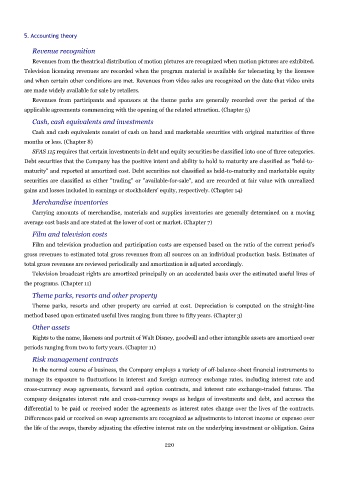Page 219 - Accounting Principles (A Business Perspective)
P. 219
5. Accounting theory
Revenue recognition
Revenues from the theatrical distribution of motion pictures are recognized when motion pictures are exhibited.
Television licensing revenues are recorded when the program material is available for telecasting by the licensee
and when certain other conditions are met. Revenues from video sales are recognized on the date that video units
are made widely available for sale by retailers.
Revenues from participants and sponsors at the theme parks are generally recorded over the period of the
applicable agreements commencing with the opening of the related attraction. (Chapter 5)
Cash, cash equivalents and investments
Cash and cash equivalents consist of cash on hand and marketable securities with original maturities of three
months or less. (Chapter 8)
SFAS 115 requires that certain investments in debt and equity securities be classified into one of three categories.
Debt securities that the Company has the positive intent and ability to hold to maturity are classified as "held-to-
maturity" and reported at amortized cost. Debt securities not classified as held-to-maturity and marketable equity
securities are classified as either "trading" or "available-for-sale", and are recorded at fair value with unrealized
gains and losses included in earnings or stockholders' equity, respectively. (Chapter 14)
Merchandise inventories
Carrying amounts of merchandise, materials and supplies inventories are generally determined on a moving
average cost basis and are stated at the lower of cost or market. (Chapter 7)
Film and television costs
Film and television production and participation costs are expensed based on the ratio of the current period's
gross revenues to estimated total gross revenues from all sources on an individual production basis. Estimates of
total gross revenues are reviewed periodically and amortization is adjusted accordingly.
Television broadcast rights are amortized principally on an accelerated basis over the estimated useful lives of
the programs. (Chapter 11)
Theme parks, resorts and other property
Theme parks, resorts and other property are carried at cost. Depreciation is computed on the straight-line
method based upon estimated useful lives ranging from three to fifty years. (Chapter 3)
Other assets
Rights to the name, likeness and portrait of Walt Disney, goodwill and other intangible assets are amortized over
periods ranging from two to forty years. (Chapter 11)
Risk management contracts
In the normal course of business, the Company employs a variety of off-balance-sheet financial instruments to
manage its exposure to fluctuations in interest and foreign currency exchange rates, including interest rate and
cross-currency swap agreements, forward and option contracts, and interest rate exchange-traded futures. The
company designates interest rate and cross-currency swaps as hedges of investments and debt, and accrues the
differential to be paid or received under the agreements as interest rates change over the lives of the contracts.
Differences paid or received on swap agreements are recognized as adjustments to interest income or expense over
the life of the swaps, thereby adjusting the effective interest rate on the underlying investment or obligation. Gains
220

